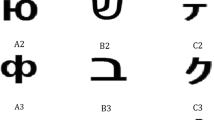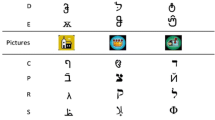Abstract
This study examined the effects of a successive stimulus pairing procedure (respondent training) on formation of conditional discriminations and equivalence classes. Different training protocols (linear, many-to-one, one-to-many), and training and test arrangements (simultaneous, simple-to-complex) were used. A simultaneous protocol was used in Experiment 1. During training, adults were exposed to multiple random series of stimulus pairs. Stimuli of the same pair were presented one after the other (e.g., A1 ➝B1, C1 ➝B1, A2➝B2, C2 ➝B2, A3 ➝B3, C3➝B3). These series were followed by a match-to-sample test series involving symmetry probes (e.g., B-A, B-C) mixed with equivalence probes (A-C). Experiments 2 through 4 involved preschool children. Experiment 2 was a modified replication of Experiment 1 (Observing A➝B and C➝B. Testing A-B, C-B, A-C, and vice versa). Experiment 3 was the same except that a simple-to-complex protocol was used (e.g., training A➝B, testing A-B and B-A, training C➝B, testing B-C and C-B, and testing A-C and C-A). Experiment 4 was the same as Experiment 3 except that only symmetry and equivalence relations were tested (e.g., training A➝B, testing B-A, training C➝B, testing B-C, and testing C-A). Symmetry and equivalence were obtained most quickly with adults trained on simultaneous many-to-one protocols. With children, however, the simultaneous protocol was not effective. The simple-to-complex protocol produced much better results which were virtually the same for all training arrangements (linear, many-to-one, one-to-many).
Similar content being viewed by others
References
ADAMS, B. J., FIELDS, L., & VERHAVE, T. (1993). Effects of test order on intersubject variability during equivalence class formation. The Psychological Record, 43, 133–152.
BARNES, D. (1994). Stimulus equivalence and relational frame theory. The Psychological Record, 44, 91–124.
BARNES, D., BROWNE, M., SMEETS, P. M., & ROCHE, B. (1995). A transfer of functions and a conditional transfer of functions through equivalence relations in three-to six-year-old children. The Psychological Record, 45, 405–430.
BARNES, D., & HOLMES, Y. (1991). Radical behaviorism, stimulus equivalence, and human cognition. The Psychological Record, 41, 19–31.
BARNES, D., & KEENAN, M. (1993). A transfer of functions through derived arbitrary and nonarbitrary stimulus relations. Journal of the Experimental Analysis of Behavior, 59, 61–81.
BARNES, D., MCCULLAGH, P. D., & KEENAN, M. (1990). Equivalence class formation in non-hearing impaired and hearing impaired children. The Analysis of Verbal Behavior, 8, 19–30.
DEVANY, J. M., HAYES, S. C., & NELSON, R. O. (1986). Equivalence class formation in language-able and language-disabled children. Journal of the Experimental Analysis of Behavior, 46, 243–257.
DUBE, W. V., MCILVANE, W. J., MACKAY, H. A., & STODDARD, L. T. (1987). Stimulus class membership established via stimulus-reinforcer relations. Journal of the Experimental Analysis of Behavior, 47, 159–175.
FIELDS, L., LANDON-JIMENEZ, D. V., BUFFINGTON, D. M., & ADAMS, B. J. (1995). Maintained nodal-distance effects in equivalence classes. Journal of the Experimental Analysis of Behavior, 64, 129–145.
GREENWAY, D. E., DOUGHER, M. J., & WULFERT, E. (1996). Transfer of consequential functions via stimulus equivalence: Generalization to different testing contexts. The Psychological Record, 46, 131–143.
HAYES, L. J. (1992). Equivalence as a process. In S. C. Hayes & L. J. Hayes (Eds.), Understanding verbal relations (pp. 97–108). Reno, NV: Context Press.
HAYES, S. C. (1991). A relational theory of stimulus equivalence. In L. J. Hayes & R. N. Chase (Eds.), Dialogues on verbal behavior (pp. 19–40). Reno, NV: Context Press.
KENNEDY, C. H., & LAITINEN, R. (1988). Second-order conditional control of symmetrical and transitive stimulus relations: The influence of order effects. The Psychological Record, 38, 437–446.
LAZAR, R. (1977). Extending sequence-class membership with matching to sample. Journal of the Experimental Analysis of Behavior, 27, 381–392.
LEADER, G., BARNES, D., & SMEETS, P. M. (1996). Establishing equivalence relations by using a respondent-type training procedure. The Psychological Record, 46, 685–706.
LYNCH, D. C., & CUVO, A. J. (1995). Stimulus equivalence instruction of fraction-decimal relations. Journal of Applied Behavior Analysis, 28, 115–126.
MACDONALD, R. F., DIXON, L. S., & LEBLANC, J. M. (1986). Stimulus class formation following observational learning. Analysis and Intervention in Developmental Disabilities, 6, 73–87.
SAUNDERS, R. R., & GREEN, G. (1992). The nonequivalence of behavioral and mathematical equivalence. Journal of the Experimental Analysis of Behavior, 57, 227–241.
SAUNDERS, K. J., SAUNDERS, R. R., WILLIAMS, D. C., & SPRADLIN, J. E. (1993). An interaction of instructions and training design on stimulus class formation: Extending the analysis of equivalence. The Psychological Record, 43, 725–744.
SAUNDERS, K. J., & SPRADLIN, J. E. (1989). Conditional discrimination in mentally retarded adults: The effect of training the component simple discriminations. Journal of the Experimental Analysis of Behavior, 52, 1–12.
SAUNDERS, R. R., WACHTER, J., & SPRADLIN, J. E. (1988). Establishing auditory stimulus control over an eight-member equivalence class via conditional discrimination procedures. Journal of the Experimental Analysis of Behavior, 49, 95–115.
SCHENK, J. J. (1995). Complex stimuli in nonreinforced simple discrimination tasks: Emergent simple and conditional discriminations. The Psychological Record, 45, 447–494.
SIDMAN, M. (1994). Equivalence relations and behavior: A research story. Boston, MA: Authors Cooperative.
SIDMAN, M., & TAILBY, W. (1982). Conditional discrimination vs matching to sample: An extension of the testing paradigm. Journal of the Experimental Analysis of Behavior, 37, 5–22.
SIDMAN, M., WYNNE, C. K., MAGUIRE, R. W., & BARNES, T. (1989). Functional classes and equivalence relations. Journal of the Experimental Analysis of Behavior, 52, 261–274.
SIGURDARDOTTIR, Z. G., GREEN, G., & SAUNDERS, R. R. (1990). Equivalence classes generated by sequence training. Journal of the Experimental Analysis of Behavior, 53, 47–63.
SMEETS, P. M., & BARNES, D. (1995). Emergent conditional discriminations in children and adults: Stimulus equivalence derived from simple discriminations. Unpublished paper.
SMEETS, P. M., BARNES, D., SCHENK, J. J., & DARCHEVILLE, J. C. (1996). Emergent simple discriminations and conditional relations in children, intellectually impaired adults, and normal adults. The Quarterly Journal of Experimental Psychology, 49B, 201–219.
SMEETS, P. M., SCHENK, J. J., & BARNES, D. (1995). Establishing arbitrary stimulus classes via identity-matching training and non-reinforced matching with complex stimuli. The Quarterly Journal of Experimental Psychology, 48B, 311–328.
SMEETS, P. M., & STRIEFEL, S. (1994). A revised blocked-trial procedure for establishing arbitrary matching in children. The Quarterly Journal of Experimental Psychology, 47B, 241–261.
SPRADLIN, J. E., & SAUNDERS, R. R. (1986). The development of stimulus classes using match-to-sample procedures: Sample classification versus comparison classification. Analysis and Intervention in Developmental Disabilities, 6, 41–58.
STODDARD, L. T., & MCILVANE, W. J. (1986). Stimulus control research and developmentally disabled individuals. Analysis and Intervention in Developmental Disabilities, 6, 155–178.
URCUIOLI, P. J., & ZENTALL, T. R. (1993). A test of comparison-stimulus substitutability following one-to-many matching by pigeons. The Psychological Record, 43, 745–759.
URCUIOLI, P. J., ZENTALL, T. R., & DEMARSE, T. (1995). Transfer of derived sample-comparison relations by pigeons following many-to-one versus one-to-many matching with identical training relations. The Quarterly Journal of Experimental Psychology, 48B, 158–178.
VAUGHAN, W. (1988). Formation of equivalence sets in pigeons. Journal of Experimental Psychology: Animal Behavior Processes, 14, 36–42.
ZYGMONT, D. M., LAZAR, R. M., DUBE, W. V., & MCILVANE, W. J. (1992). Teaching arbitrary matching via sample-control shaping to young children and mentally retarded individuals: A methodological note. Journal of the Experimental Analysis of Behavior, 57, 109–117.
Author information
Authors and Affiliations
Corresponding authors
Rights and permissions
About this article
Cite this article
Smeets, P.M., Leader, G. & Barnes, D. Establishing stimulus classes in adults and children using a respondent-type training procedure: A follow-up study. Psychol Rec 47, 285–308 (1997). https://doi.org/10.1007/BF03395226
Published:
Issue Date:
DOI: https://doi.org/10.1007/BF03395226




